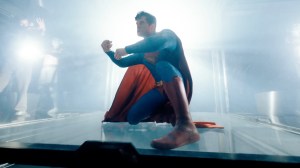NASA has had a busy few days. Bright and early Wednesday morning, the space agency successfully launched the Artemis I mission into space after a months-long delay. Fast forward a few hours and the team of researchers working on the Webb Space Telescope released one of the most stunning pictures the observatory has captured yet. NASA’s social media platforms shared a photo of a star named L1527 currently being formed in the midst of a dramatic cloud of cosmic dust. The result is an hourglass-shaped nebula with brilliant blue and orange colors strewn about.
Videos by ComicBook.com
“Despite the chaos that L1527 causes, it’s only about 100,000 years old – a relatively young body. Given its age and its brightness in far-infrared light as observed by missions like the Infrared Astronomical Satellite, L1527 is considered a class 0 protostar, the earliest stage of star formation,” NASA says of the star in the photo.
It adds, “Protostars like these, which are still cocooned in a dark cloud of dust and gas, have a long way to go before they become full-fledged stars. L1527 doesn’t generate its own energy through nuclear fusion of hydrogen yet, an essential characteristic of stars. Its shape, while mostly spherical, is also unstable, taking the form of a small, hot, and puffy clump of gas somewhere between 20 and 40% the mass of our Sun.”
It’s just the latest image released by NASA officials using the new technology aboard the Webb Space Telescope.
“If you think about that, this is farther than humanity has ever moved before,” NASA administrator Bill Nelson previously said of the JWST. “And we’re only beginning to understand what Webb can and will do. It’s going to explore objects in the solar system and atmospheres of exoplanets orbiting other stars, giving us clues as to whether potentially their atmospheres are similar to our own.”
“Our goals for Webb’s first images and data are both to showcase the telescope’s powerful instruments and to preview the science mission to come,” astronomer Klaus Pontoppidan, Webb project scientist at STScI, added of the images. “They are sure to deliver a long-awaited ‘wow’ for astronomers and the public.”









